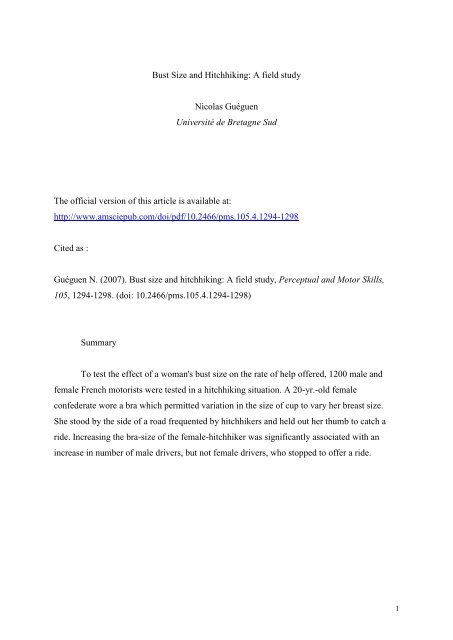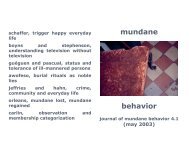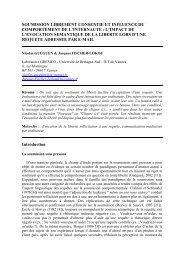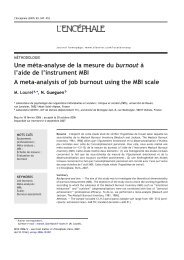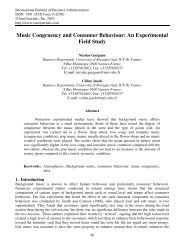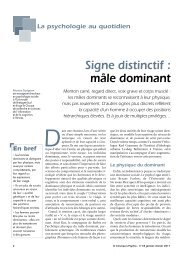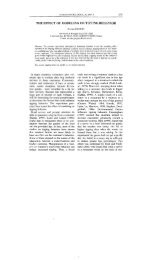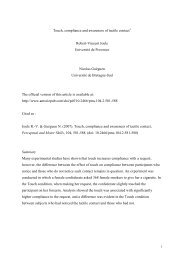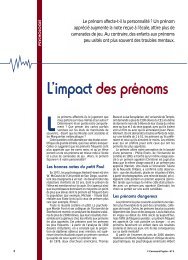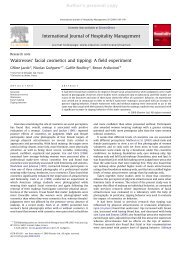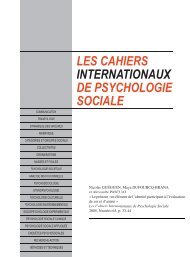Bust Size and Hitchhiking - Pr. Nicolas GUEGUEN
Bust Size and Hitchhiking - Pr. Nicolas GUEGUEN
Bust Size and Hitchhiking - Pr. Nicolas GUEGUEN
- No tags were found...
You also want an ePaper? Increase the reach of your titles
YUMPU automatically turns print PDFs into web optimized ePapers that Google loves.
<strong>Bust</strong> <strong>Size</strong> <strong>and</strong> <strong>Hitchhiking</strong>: A field study<strong>Nicolas</strong> GuéguenUniversité de Bretagne SudThe official version of this article is available at:http://www.amsciepub.com/doi/pdf/10.2466/pms.105.4.1294-1298Cited as :Guéguen N. (2007). <strong>Bust</strong> size <strong>and</strong> hitchhiking: A field study, Perceptual <strong>and</strong> Motor Skills,105, 1294-1298. (doi: 10.2466/pms.105.4.1294-1298)SummaryTo test the effect of a woman's bust size on the rate of help offered, 1200 male <strong>and</strong>female French motorists were tested in a hitchhiking situation. A 20-yr.-old femaleconfederate wore a bra which permitted variation in the size of cup to vary her breast size.She stood by the side of a road frequented by hitchhikers <strong>and</strong> held out her thumb to catch aride. Increasing the bra-size of the female-hitchhiker was significantly associated with anincrease in number of male drivers, but not female drivers, who stopped to offer a ride.1
A host of previous studies show that men <strong>and</strong> women differ in several matepreferences across cultures. Men, more than women, value physical attractiveness in a mate,whereas women, more than men, value good financial prospects <strong>and</strong> higher status (Buss,1989; Kenrick, Groth, Trost, & Sadalla, 1993; Shackelford, Schmitt, & Buss, 2005). Thisimportance of physical attractiveness for men, therefore, leads them to react promptly tovarious differences in the physical appearance of women. <strong>Pr</strong>ior studies have indicateddifferent morphological features of women are associated with varied attractiveness for themen. Furnham, Lavancy, <strong>and</strong> McClell<strong>and</strong> (2001), Henss (2000), Singh (1993), <strong>and</strong> Singh <strong>and</strong>Luis (1995) reported that lower Waist-to-Hip ratio of women was associated with greaterphysical attractiveness when evaluated by men. A ratio of .70 may represent highattractiveness (Singh, 2002). Another important morphological factor associated with femaleattractiveness is breast size. Millsted <strong>and</strong> Frith (2003) consider that large breasts have becomeover-sexualised as highly prized objects of sexual desire. <strong>Pr</strong>evious researchers found thatfemales with large breasts are highly valued. Beck, Ward-Hull, <strong>and</strong> McLear (1976) noted thatmales rated a female’s figure with breasts larger than average breast size more favorably thanothers. Wildman <strong>and</strong> Wildman (1976) stated that the bust was the most sexually stimulatingfemale body part for males <strong>and</strong> that men preferred larger busts than women typically possesson the average. Gitter, Lomranz, Saxe, <strong>and</strong> Bar-Tal (1983) found that female figures withlarge breasts were preferred by males, whereas there was no such difference in women’spreferences. Furnham, Hester, <strong>and</strong> Weir (1990) also observed through men’s evaluation offemale silhouettes with three varying of size breast that males displayed a preference forlarger breasts. Given these studies, greater attractiveness seems associated with large breastsof women. Further, in previous studies evaluation scales have been considered but notbehavioral effects of breast size.When considering men’s with respect to women’s breast size only one experiment wasfound. Morgan, Lockard, Fahrenbruch, <strong>and</strong> Smith (1975) test of a female hitchhiker’s bustsize indicated male motorists offered rides more frequently to a female confederate with anaccentuated bust compared to a normal one. In the present experiment bust size was combinedwith eye contact (a female confederate with eye contact + an accentuated bust compared withanother female confederate with normal bust but no eye contact). Thus the effect of bust sizealone on men’s courtship behavior remains undetermined. Given that most studies testing theassociation of a woman’s breast size <strong>and</strong> attractiveness to males were conducted in alaboratory setting <strong>and</strong> only with the evaluation of silhouettes, photographs or writtendescriptions, it has became important to conduct experiment to assess this association of2
east size in a field setting, with more ecological validity <strong>and</strong> with behavioral measures. Theexperiment of Morgan, et al. (1975) was conducted in a field setting <strong>and</strong> used behavioralmeasurements but some methodological problems persisted in the evaluation of the role ofbreast size. The use of hitchhiking to explore the role of some psychological variables onhuman behavior is appropriate. The positive relation of nonverbal behavior such as gaze(Snyder, Grether, &Keller, 1974; Morgan, et al., 1975) or smile (Guéguen, 2001; Guéguen &Fischer-Lokou, 2004) <strong>and</strong> driver behavior was found. Apparel worn by the hitchhiker is alsoassociated with variation in motorist behavior (Crassweller, Gordon, & Tedford, 1972).<strong>Hitchhiking</strong> appeared to be a good setting to evaluate some social psychological variables <strong>and</strong>human behavior. Then testing the effect of the appearance of female-hitchhikers on maledrivers’ behavior seems suitable. On studies on hitchhiking, females received more rides thanmales (Clifford & Cleary, 1971; Pomazal & Clore, 1973; Snyder, et al., 1974; Morgan, et al.,1975; Guéguen, 2001; Guéguen & Fischer-Lokou, 2004) also drivers who offered help weremales.An evaluation of the effect of the bust size of a female hitchhiker was then carried outwhere the bust size of a female confederate was controlled experimentally. The experimentwas conducted in France where hitchhiking is legal <strong>and</strong> so one frequently sees hitchhikers onthe side of the road. Mermet (2006) found that 78.0 % of people have hitchhiked. Of themotorists who stopped, 96.3 % were males. According to previous studies it was hypothesizedthat increase in bust size would be associated with greater number of male drivers stopping tohelp the female hitchhiker, whereas no difference would be found for female drivers.MethodParticipantsDrivers (774 men <strong>and</strong> 426 women) solicited at the entry of a famous peninsula(“<strong>Pr</strong>esqu'Île de Rhuys”) of Brittany in France, were the participants. The experiment wasconducted during the beginning of the summer holidays on sunny days. The place in whichthe experiment was conducted was one at which hitchhikers waited for a motorist.<strong>Pr</strong>ocedure3
A young woman of twenty year was a confederate in this experiment. She was selectedfrom members of a group of female students who volunteered for this experiment. She wasselected because she was rated by 15 male students to possess an average physicalattractiveness <strong>and</strong> because she had a bust size smaller than young women of their agetypically possess on the average. She usually wore bra with a “A” size cup which is in Francethe smaller cup of bra. By adding a latex leaf, size of the cup was increased to simulate a “B”size cup (the average cup in France) <strong>and</strong> the “C” size (the size immediately larger than theaverage size of the cup of young women in France). In the three experimental conditions,three different bras were used but they varied only according to size cup: the same model wasused. Except for the type of bra used according to the different experimental conditions, thesame clothes were worn, pair of neat jeans, sneakers of light colors, <strong>and</strong> a white figurehuggingshirt which highlighted the confederate bust. In the three experimental conditions, theconfederate was instructed not to use cosmetics, <strong>and</strong> her hair-style remained constant acrossconditions.The female confederate was stood at the side of the road in good visibility of motorists<strong>and</strong> with a broad road zone, making a stop <strong>and</strong> restarting of vehicles quite easy <strong>and</strong> safe. Theexperiment took place between 2 p. m. <strong>and</strong> 6 p. m. during week ends on sunny pleasant daysin early summer. Two observers waiting in a car parked on the opposite side of the road 500meters behind the place at which the confederate stood, were instructed to count the numberof motorists on the opposite side <strong>and</strong> to note if the motorist was a man or a woman. Each ofthem used two h<strong>and</strong>-held counters (one to count the female motorists <strong>and</strong> the other to countthe male motorists). The convergence between the two observers’ evaluation was high (r =.98). The confederate was also instructed to count the number of motorists <strong>and</strong> to change herbra after 100 motorists passed along side of the road on which the experiment was carried out(about 40 to 50 minutes). When a car came, the confederate was instructed to hold her thumb(a nonverbal behavior that means in France somebody is a hitchhiker) <strong>and</strong> to look along theside of the road. That a driver stopped qualified the person as an helper. The confederate wasthen instructed to debrief the participant. She explained to the driver that she was conductingan experiment on hitchhiking. Then, the driver was warmly thanked for help. Thisinformation procedure was used in accord with the suggestion of the Ethic Committee of thelaboratory prior to evaluating the experiment. To prevent problems, a male observer discreetlyobserved the female confederate from a distance of 30 meters away from the confederate. Itwas not possible for the motorists to see the observer who observed the scene. He wasinstructed to come near the confederate if something wrong occurred. Fortunately, no4
intervention by this observer was required. This procedure was adapted on suggestion by theEthic Committee.ResultsThe number of drivers who stopped by sex conditions is presented in Table 1.Table 1Frequency <strong>and</strong> Percent of Motorists Who Stopped According By Experimental Condition <strong>and</strong>Sex motoristGroup<strong>Size</strong> level of the bra cupA B CMale motorists (t = 774) %f14.9240/26817.9746/25624.0060/250Female motorists (n = 426) %f9.0912/1327.6411/1449.33 %14/150To the frequencies observed chi-square dependency test was applied. In malemotorists responses to the three bust sizes was significantly different (² (2, N = 774) = 7.16, p
the previous studies in which larger bust size of women were rated higher in physicalattractiveness (Furnham, Dias, & McClell<strong>and</strong>, 1998). This greater attractiveness should thenbe reflected by more male drivers to help a woman perceived as more attractive.ReferencesBeck, S. B., Ward-Hull, C. I., & McLear, P. M. (1976) Variables related to women’s somaticpreferences of the male <strong>and</strong> female body. Journal of Personality <strong>and</strong> SocialPsychology, 34, 1200-1210.Buss, D. M. (1989) Sex differences in human mate preferences: evolutionary hypothesestested in 37 cultures. Behavioral <strong>and</strong> Brain Sciences, 12, 1-49.Clifford, M., & Cleary, P. (1971) The odds in hitchhiking. Psychology Today, 5, June, 38.Crassweller, P., Gordon, M., & Tedford, W. (1972) An experimental investigation ofhitchhiking. Journal of Psychology, 82, 43-47.Furnham, A., Dias, M., & McClell<strong>and</strong>, A. (1998) The role of body weight, waist-to-hip ratio,<strong>and</strong> breast size in judgments of female attractiveness. Sex Roles, 39, 311-326.Furnham, A., Hester, C., & Weir, C. (1990) Sex differences in the preferences for specificfemale body shapes. Sex Roles, 22, 743-754.Furnham, A., Lavancy, M., & McClell<strong>and</strong>, A. (2001) Waist to hip ratio <strong>and</strong> facialattractiveness: a pilot study. Personality <strong>and</strong> Individual Differences, 30, 491-502.Gitter, G. A., Lomranz, J., Saxe, L., & Bar-Tal, Y. (1983) Perceptions of female physiquecharacteristics by American <strong>and</strong> Israeli students. Journal of Social Psychology, 121, 7-13Guéguen, N. (2001) Effect of humor on hitchhiking: a field experiment. North AmericanJournal of Psychology, 3, 369-376.Guéguen, N., & Fischer-Lokou, J. (2004) Hitchhikers’ smile <strong>and</strong> receipt of help.Psychological Reports, 94, 756-760.Henss, R. (2000) Waist-to-hip ratio <strong>and</strong> female attractiveness: evidence from photographicstimuli <strong>and</strong> methodological considerations. Personality <strong>and</strong> Individual Differences, 28,501–513.Kenrick, D. T. Groth, G. E., Trost, M. R., & Sadalla, E. K. (1993) Integrating evolutionary<strong>and</strong> social exchange perspectives on relationships: effects of gender, self-appraisal,<strong>and</strong> involvement level on mate selection criteria. Journal of Personality <strong>and</strong> SocialPsychology, 64, 951-969.6
Mermet, G. (2006) Francoscopie. Paris: Larousse.Morgan, C., Lockard, J., Fahrenbruch, C., & Smith, J. (1975) <strong>Hitchhiking</strong>: social signals at adistance. Bulletin of the Psychonomic Society, 5, 459-461.Pomazal, R., & Clore, G. (1973) Helping on the highway: the effects of dependency <strong>and</strong> sex.Journal of Applied Social Psychology, 3, 150-164.Singh, D. (1993) Adaptive significance of female physical attractiveness: role of the waist-tohipratio, Journal of Personality <strong>and</strong> Social Psychology, 65, 293-307.Singh, D. (2002) Female mate value at a glance: relationship of waist-to-hip ratio to health,fecundity <strong>and</strong> attractiveness. Human Ethology <strong>and</strong> Evolutionary Psychology, 23, 81-91.Singh, D., & Luis, S. (1995) Ethnic <strong>and</strong> gender consensus for the effect of waist-to-hip ratioon judgements of women’s attractiveness. Human Nature, 6, 51-65.Snyder, M., Grether, J., & Keller, K. (1974) Staring <strong>and</strong> compliance: a field experiment onhitchhiking. Journal of Applied Social Psychology, 4, 165-170.Wildman, R. W., & Wildman, R. W. (1976) Note on males’ <strong>and</strong> females’ preferences foropposite-sex body parts, bust sizes, <strong>and</strong> bust-revealing clothing. PsychologicalReports, 38, 485-486.7


